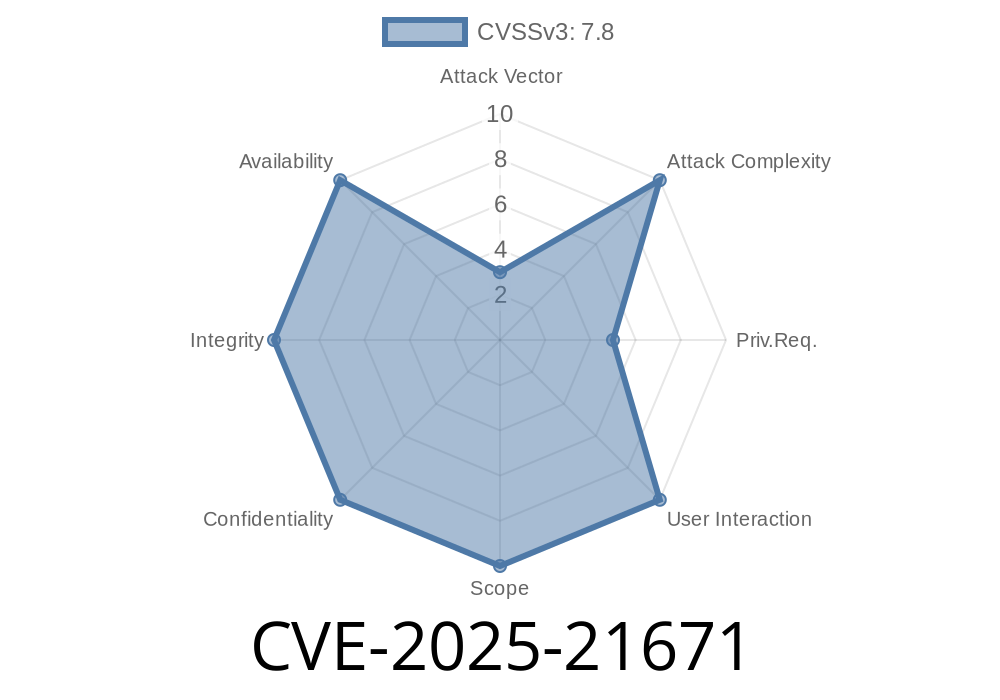In early 2025, a significant security vulnerability in the Linux kernel's zram driver was assigned as CVE-2025-21671. The problem, technically described as a "potential use-after-free (UAF) of zram table," exposes a classic memory safety bug: freeing a memory structure, forgetting to nullify the pointer, and then accidentally using the pointer again. This post breaks down the vulnerability, walks through a simplified code example, offers a conceptual exploit scenario, and provides links to official references.
What Is zram and Why Does It Matter?
zram is a Linux kernel module that provides a compressed block device in RAM. It's popular for swap-on-RAM, embedded systems, and anywhere you want fast, compressed in-memory storage.
A bug in zram can potentially lead to kernel crashes, privilege escalations, or even full system compromise—especially if an unprivileged user can create, reset, or mess with zram devices.
The pointer to zram->table is freed but not set to NULL.
- If the user then resets the failed device, the cleanup (zram_meta_free) touches this pointer—use after free!
This type of bug often lets attackers get the kernel to access previously freed memory, which could contain attacker-controlled data.
Let's look at a simplified, illustrative version of the vulnerable logic
// Vulnerable code (before the fix)
int zram_meta_alloc(struct zram *zram) {
zram->table = kmalloc(sizeof(...), GFP_KERNEL);
if (!zram->table) {
kfree(zram->table); // Frees the memory (table is now dangling)
// Missing: zram->table = NULL;
return -ENOMEM;
}
return ;
}
void zram_meta_free(struct zram *zram) {
kfree(zram->table); // Will access freed memory if previous alloc failed
}
Key Problem: After freeing the memory, the zram->table pointer still points to the old memory. Nothing stops later kernel code from accessing, reading, or writing to it.
The Official Patch
The fix is simple but crucial: Set the pointer to NULL after freeing it.
// Patch (the fix)
if (zram->table) {
kfree(zram->table);
zram->table = NULL;
}
See the commit here (kernel.org)
Exploit Scenario: How Could This Be Used?
Imagine a local attacker who can create and reset zram devices—think of an unprivileged user in a container, a buggy system service, or a clever script.
1. Trigger Allocation Fail: The attacker exhausts kernel memory or uses a crafted input that forces zram_meta_alloc to fail. Maybe this is with huge device sizes or in a memory-pressure situation.
Reset the Device: The attacker resets the zram device, calling zram_meta_free.
4. Use-After-Free: The kernel thinks zram->table is still valid and accesses recycled memory—potentially now controlled by attacker.
5. Arbitrary Code or Information Disclosure: If the attacker can control what occupies the freed memory, this can lead to code execution or kernel information leaks.
Proof-of-Concept (Conceptual)
A real-world exploit against modern kernels is hard—kernel heap layout is unpredictable. Still, here's a conceptual C code that could help a researcher test the bug on a vulnerable kernel:
// For demonstration use only!
// 1. Trigger memory allocation failure
// 2. Immediately call reset to free the same pointer twice
// In userspace:
system("modprobe zram");
system("echo 1 > /sys/class/zram-control/hot_add");
// Try a large value to force allocation failure (example: 1TiB)
system("echo $((1<<40)) > /sys/class/zram/zram/disksize");
// Immediately reset the device
system("echo 1 > /sys/class/zram/zram/reset");
Note: This code will not work on patched kernels, and in the real world, extra steps would likely be needed.
References & Further Reading
- Linux Kernel Patch Commit
- Kernel.org zram Documentation
- CVE Record: CVE-2025-21671 (link goes live after Mitre review)
Recommendations and Mitigation
- Update the Kernel: If you use zram or run multi-tenant environments, update to a kernel version including the patch (post January 2025).
Conclusion
CVE-2025-21671 may sound like a simple pointer mistake, but as with many kernel bugs, small errors can have outsize impacts on Linux security. The fix is out; patch as soon as possible. Details on real-world exploitation will likely emerge in the coming months, so defenders and researchers alike should stay informed.
Timeline
Published on: 01/31/2025 12:15:28 UTC
Last modified on: 05/04/2025 07:18:44 UTC
